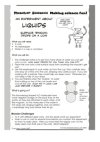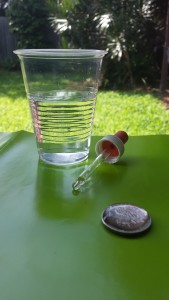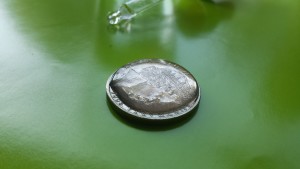How many drops of water can you get onto a coin? This liquids science experiment is a fabulous way to investigate surface tension and the molecular attraction of water.
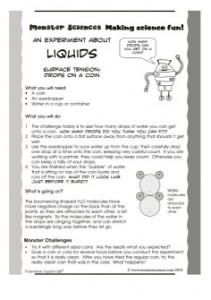 |
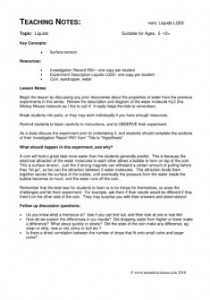 |
What you will need:
- A coin
- An eyedropper
- Water in a cup or container
What you will do:
- The challenge today is to see how many drops of water you can get onto a coin. How many drops do you think you can fit?
- Place the coin onto a flat surface away from anything that shouldn’t get wet.
- Use the eyedropper to suck water up from the cup, then carefully drop one drop at a time onto the coin, keeping very careful count. If you are working with a partner, they could help you keep count. Otherwise you can keep a tally of your drops.
- You are finished when the “bubble” of water that is sitting on top of the coin bursts and runs off the coin. What did it look like just before it burst?
What is going on?
The boomerang shaped H2O molecules have more negative charge on the back than at the points, so they are attracted to each other, a bit like magnets. So the molecules of the water in the drops are clinging together, and can stretch a surprisingly long way before they let go.
Monster Challenges:
- Try it with different sized coins. Are the results what you expected?
- Soak a coin in cola for several hours before you conduct the experiment so that it is really clean. After you have tried the regular coin, try the really clean coin that was in the cola. What happens?
Teaching Notes:
Topic:
Liquids
Key Concepts:
Surface tension
Resources:
- Investigation Record IR01– one copy per student
- Experiment Description Liquids LQ03– one copy per student
- Coin, eyedropper, water
Lesson Notes:
Begin the lesson by discussing any prior discoveries about the properties of water from the previous experiments in this series. Review the description and diagram of the water molecule H2O (the Mickey Mouse molecule as I like to call it! It really helps the kids to remember).
Break students into pairs, or they may work individually if you have enough resources.
Remind students to listen carefully to instructions, and to OBSERVE their experiment.
As a class discuss the experiment prior to undertaking it, and students should complete the sections of their Investigation Report IR01 from ”Title to “Hypothesis”.
What should happen in this experiment, and why?
A coin will hold a great deal more water than the students generally predict. This is because the electrical attraction of the water molecules to each other allows a bubble to form on top of the coin. This is surface tension. Just like 2 strong magnets can withstand a certain amount of pulling before they “let go”, so too can the attraction between 2 water molecules. This attraction binds them together across the surface of the bubble, until eventually the pressure from the water inside the bubble becomes to much, and the water runs off the coin.
Remember that the best way for students to learn is to try things for themselves, so pose the challenges and let them experiment. For example, ask them if their results would be different if they tried it on the other side of the coin. They may surprise you with their answers and observations!
Follow up discussion questions:
- Do you know what a meniscus is? See if you can find out, and then look at one in real life!
- How do we explain the differences in our results? Did dropping water from higher or lower make a difference? What about quickly or slowly? Did the state of the coin make any difference, eg clean or dirty, new or old, shiny or dull etc.?
- Is there a direct correlation between the number of drops that fit onto small coins and larger coins?

